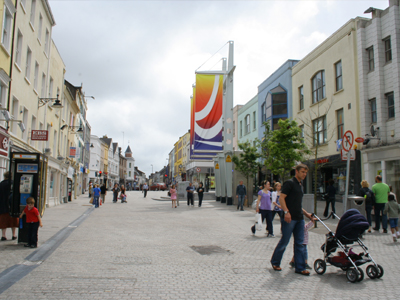Waterford City continued 1
 Prince John
Prince John
A few decades later, Harry's younger son, Prince John, Lord of Ireland, made the very same trip to Waterford and established a Royal Mint in Reginald's Tower. As King of England, John found time on two occasions to slip away from his war with Robin Hood to visit the new Norman City of Waterford. He granted the town its first charter in 1205, then added a further 33 acres to the settlement and fortified the whole shabang in 1210. The green light for boom time went ahead. The Franciscans (Grey Friars) and Dominicans (White Friars) arrived presently and set the educational ball rolling. Curious 21st century visitors can still see remnants of John's legacy in the medieval walls of Railway Square, Castle Street, Stephen Street and Jenkins Lane.
In terms of development, Waterford was much helped by the Golden Age in Ireland that followed the arrival of the industrious, feudal-spirited stone-building Normans. The country experienced unprecedented economic growth and prosperity right through until the late 13th century when the cost of Edward Longshanks' military campaigns in France, Wales, Scotland and Ireland finally began taking their toll. For the duration of the 13th century, Waterford was the unofficial capital of Norman-occupied Ireland.
Reginald's Tower
The 73 foot high round tower on the east of Waterford's quays has an impressive CV, having served as a Viking lookout post, Norman wedding venue, royal residence, royal mint, military storage dept and town jail before taking on its present career as Waterford's Civic and Maritime Museum. The tower was originally a defensive wooden structure built by Reginald the Dane, Governor of Vadrefjord. The present tower was erected by the Normans in the late 12th century.
If you want a city to make money, you have to make the money. The first mint was established at Reginald's' Tower in Waterford by Prince John in the late 12th century and was a huge help to Waterford's bid to be taken seriously as a lucrative medieval port. Coinage was made by hand round the clock from 1281 onwards when King Edward Longshanks appointed the Bishop of Waterford to oversee the operation. Longshanks needed every penny he could muster to pay for his military campaigns against Llewelyn in Wales, Robert Bruce and William "Braveheart" Wallace in Scotland, not to mention the French in Gascony and the Gaelic clans of Ireland. The Fulbournes had run of the show for over a decade, heroically bankrupting the Irish economy in the process, before the Waterford mint was closed in 1295 and transferred to Cork where the new Anglo-Norman Governor of Ireland, Thomas Fitzmaurice Fitzgerald had his estate.
Great Pretenders
For nearly four centuries, Waterford honoured the oath of loyalty sworn by its inhabitants to Henry II in 1171. Richard II swung by in 1394 just to keep everyone happy. When Lambert Simnell was dubiously crowned King of England and Ireland in Dublin in 1487, Waterford remained loyal to Henry VII. When Perkin Warbeck tried to claim the throne in July 1495, his army laid siege to Waterford. This is now regarded as the first siege in Ireland to have involved the use of cannon by both sides. One of these cannons, dredged from the River Barrow, is now on display in Reginald's Tower Museum, while the walls of the tower also bear the scars of Warbeck's canons. The citizens of Waterford not only repulsed the happy-go-lucky Pretender but even managed to chase him back across the Irish Sea to Cornwall. Henry VII was so chuffed with this loyalty that he gave the City of Waterford 1000 marks and conferred on it the title Intacta Manet Waterfordia, which still appears on the city arms.
From the 13th to the 17th century, Waterford boomed as an international trading port, importing and exporting goods from England, Spain, Portugal and France. However, the city didn't fare so well under Henry VII's soon-to-be-Protestant heirs, King Henry the Eighth, and his daughter, Elizabeth Tudor. The problem was the citizens of Waterford were Catholics and, while they were well on for regarding the English monarch as head of state, they still reckoned the Pope was head of the Church no matter which way you looked at it. The Tudors thought different and sent their soldiers over: the Dominican and Franciscan monasteries were suppressed, Waterford was stripped of its city charter and several members of the Corporation were either fined or bunged into a manky prison cell for a few decades.